Cyber Security For Industrial Automation Market Insights, 2032
The global cyber security for industrial automation market size was valued at $9 billion in 2022, and is projected to reach $20.5 billion by 2032, growing at a CAGR of 8.7% from 2023 to 2032.
Cybersecurity in industrial automation or Industry 4.0 and the smart manufacturing sector has gained immense popularity in recent times. This is because cyber security helps in protecting the critical infrastructure present in the industrial sector and the sensitive information from cyber threats. Industrial automation systems or processes use several control systems, sensors, and technologies. These systems are often connected to networks making them susceptible to various cyber threats and cyber-attacks. Thus, in the energy, transportation, and manufacturing sector, the cyber security measures are necessary to protect critical infrastructure from unauthorized access and disruptions.
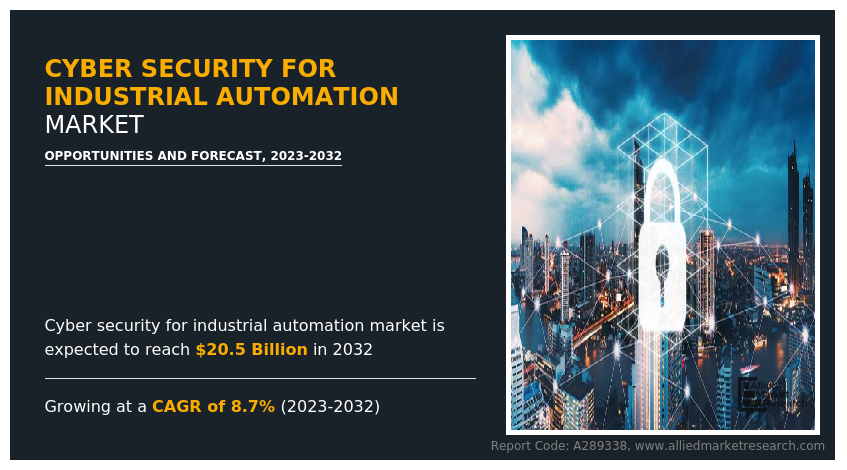
The growing popularity of cyber security in detecting and responding to cyber threats as well as maintaining data integrity and confidentiality is anticipated to boost the cybersecurity for industrial automation market growth in the upcoming years. For instance, in cyber security, intrusion detection systems and security monitoring tools are implemented for identifying and responding to potential cyber threats in real-time. This is a proactive approach that helps in mitigating the impact of security incidents and preventing data loss.
In addition, maintaining the integrity and confidentiality of data is important in industrial automation. Hence, cyber security measures such as data encryption and secure storage practices must be implemented by all the industrial processes to protect the sensitive data from unauthorized access and tampering.
Outdated legacy systems and compliance issues while integrating different cyber security tools & technologies is anticipated to restrain the market growth. For instance, most legacy systems were manufactured, quite ago owing to which they use different manufacturing approaches. In such cases, the issue arises while adopting new cyber security technologies into existing systems. Furthermore, most legacy systems focus on integrity and availability rather than security owing to which the digitalization of supply chain management processes becomes complicated. Thus, the difference between legacy systems and modern IoT systems is a significant challenge for implementing cybersecurity measures in the industrial sector.
The integration of new technologies in industrial automation sector such as behavioral analytics and blockchain to generate excellent opportunities in the market. Behavioral analytics presents an opportunity for cybersecurity professionals to significantly enhance threat detection capabilities. By analyzing patterns of behavior across websites, mobile applications, systems, and networks, early identification of potential threats and vulnerabilities becomes possible.
In addition, the adoption of behavioral analytics allows organizations to detect potential attacks early in their lifecycle. Analyzing unusual events and actions provides insights into cybersecurity threats, enabling proactive responses. Moreover, the predictive capability of behavioral analytics empowers organizations to anticipate and prepare for future cyber threats. Furthermore, the application of blockchain technology in cybersecurity introduces opportunities for secure data management. Blockchain securely stores data in immutable blocks, connected through cryptography. Cybersecurity professionals can leverage this innovation to enhance the security of systems and devices.
The key players profiled in this report include IBM, ABB, Schneider Electric, Honeywell International Inc., Siemens AG, Microsoft Corporation, Rockwell Automation Inc., Palo Alto Networks, Cisco Systems, Inc., and Dell Inc.
Technological advancement and product launch are common strategies followed by major market players. For instance, in October 2023, Dragos Inc., leading company in cybersecurity for industrial control systems (ICS) and operational technology (OT) environments, unveiled an extension of their collaborative capabilities in conjunction with Rockwell Automation, the largest company in industrial automation and digital transformation. This partnership will help in enhancing threat detection for ICS/OT cybersecurity.
The cyber security for industrial automation market is segmented on the basis of type, tools or technologies, security type, end use, and region. By type, the market is divided into fixed automation system, programmable automation system, flexible automation system, and integrated automation system.
By tools or technologies, the market is classified into numerical control (NC) machine tools, programmable logic controllers (PLCs), computer numerical control (CNC) systems, and industrial sensors. By security type, the market is analyzed across enterprise security, SCADA security (supervisory control and data acquisition), network security, device security, and physical security. By end use, the market is classified into automotive manufacturing, electronics & telecommunication, food & beverage processing, pharmaceuticals, and others. By region, the market is analyzed across North America, Europe, Asia-Pacific, and LAMEA.
The Market is Segmented into Security Type, End Use, Type and Tools or Technologies
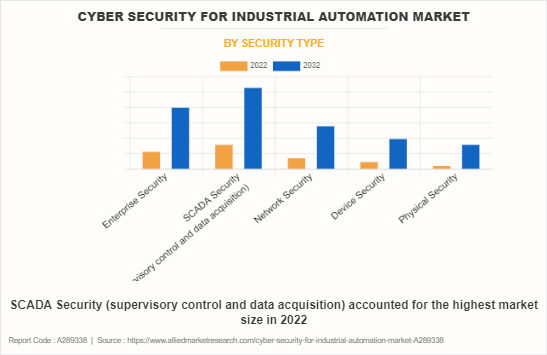
By security type, the SCADA security (Supervisory Control and Data Acquisition) sub-segment dominated the global cyber security for industrial automation market in 2022. SCADA systems play a crucial role in industrial automation by providing remote monitoring and control capabilities. One of the primary drivers for SCADA security in cybersecurity is the need to protect critical processes from cyber threats.
In addition, ensuring the integrity and security of SCADA systems is essential to safeguarding vital industrial processes from potential disruptions and unauthorized access. SCADA's capability for efficient centralized process control is driving the demand for cyber security in industrial automation. Protecting the integrity of the centralized control infrastructure is paramount to prevent malicious interference, ensuring that control commands and data exchanges remain secure and uncompromised.
The real-time monitoring and data acquisition features of SCADA contribute to informed decision-making. Security measures in SCADA systems are driven by the necessity to protect real-time data from manipulation or unauthorized access. This enables organizations to make reliable decisions based on accurate and secure information. Furthermore, the SCADA systems are designed to enhance operational efficiency and contribute to cost savings. Cybersecurity measures for SCADA aim to protect against potential cyber threats that could disrupt operations, ensuring continuous and efficient processes. By securing SCADA systems, organizations can mitigate risks and avoid costly downtimes.
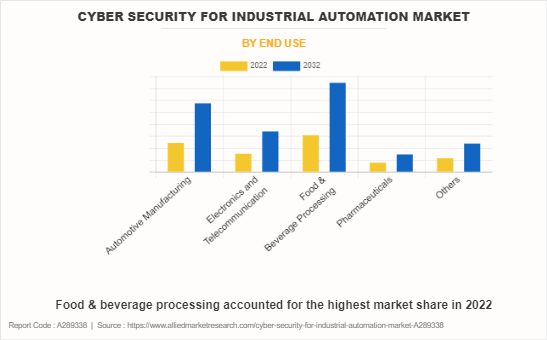
By end use, the food & beverage processing sub-segment dominated the global cyber security for industrial automation industry share in 2022. The food & beverage industry relies heavily on computer-controlled automation systems for its productivity. Cybersecurity is a critical factor to protect these sophisticated systems from cyber threats. Ensuring the security of critical infrastructure is paramount to prevent disruptions that could compromise production processes and impact the food supply chain. Modern food & beverage plants heavily depend on automation for their productivity.
Cybersecurity measures are crucial to prevent downtime caused by cyberattacks. The financial losses resulting from disruptions in production processes can also be substantial. Implementing robust cybersecurity safeguards helps minimize these risks and ensures continuous operations. In the food & beverage industry, intellectual property, such as proprietary recipes, formulations, and processes, is a valuable asset. Cybersecurity is a major factor to protect this intellectual property from theft or unauthorized access. Safeguarding these assets is vital for maintaining a competitive edge and preserving the uniqueness of products.
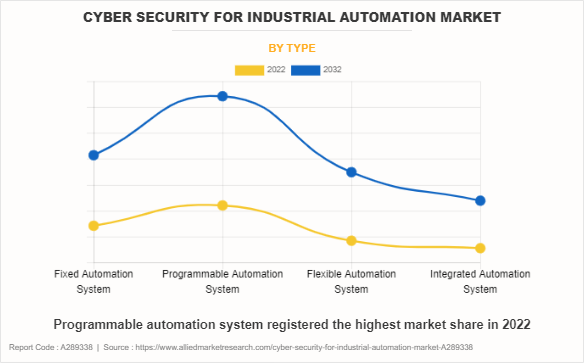
By type, the programmable automation system sub-segment dominated the market in 2022. Programmable automation systems offer a high degree of adaptability and flexibility in manufacturing processes. The ability to easily modify control programs allows for swift adjustments to product or process changes.
In terms of cybersecurity, this adaptability ensures that security measures can be quickly adjusted to address evolving cyber threats and vulnerabilities. The nature of programmable automation systems is well-suited for batch production processes, especially in industries producing similar items using the same automated steps and tools. Furthermore, the programmable automation systems enable the seamless implementation of new processes through modification of the control program.
From an industrial cybersecurity perspective, this capability aligns with the need for continual improvement and adaptation of cybersecurity protocols to address emerging threats or changes in the manufacturing environment. In addition, the programmable nature of automation systems facilitates industrial cybersecurity training. Cybersecurity professionals can leverage the adaptability of these systems to simulate various cyber threat scenarios, providing practical training opportunities to enhance the overall cyber resilience of the industrial environment.
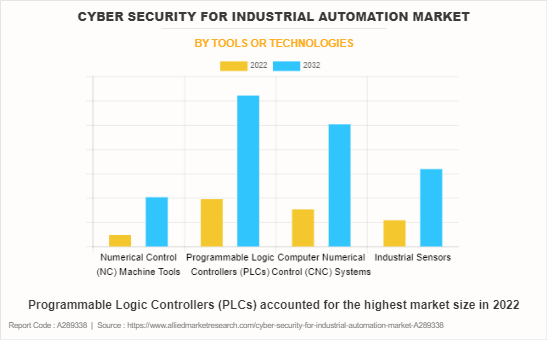
By tools or technologies, the programmable logic controllers (PLCs) sub-segment dominated the global cyber security for industrial automation market share in 2022. The flexibility of programmable logic controllers (PLCs) in industrial automation allows for efficient adaptation to evolving cybersecurity requirements. PLCs can be easily reprogrammed to incorporate new security protocols, respond to emerging threats, and adapt to changes in the industrial environment. PLCs offer enhanced reliability and robust operation compared to traditional relay-based control systems.
Their design to operate in harsh industrial environments, along with built-in protection against electrical noise and temperature extremes, ensures consistent and dependable performance. This reliability extends to cybersecurity measures, providing a stable foundation for secure industrial processes. PLCs provide ease of maintenance in industrial automation systems. Their modular design allows for straightforward replacement and updates, facilitating the integration of the latest cybersecurity features and patches. This simplifies the process of maintaining and upgrading security measures without disrupting overall operations.
PLC systems are highly scalable, enabling easy expansion by adding additional modules or controllers. This scalability is advantageous in cybersecurity, allowing organizations to scale up security measures in tandem with the growing complexity of industrial automation systems and the increasing sophistication of cyber threats. Many modern PLC systems support remote accessibility, providing cybersecurity professionals with the ability to monitor and troubleshoot systems from a distance. This remote access streamlines cybersecurity operations, allowing for quick responses to potential threats and efficient troubleshooting without the need for physical presence.
The data logged by PLC systems can be utilized for predictive maintenance, contributing to cybersecurity efforts. Predictive maintenance enables the identification of potential security vulnerabilities and system weaknesses before they lead to operational disruptions. This proactive approach minimizes downtime and enhances the overall resilience of industrial automation systems.
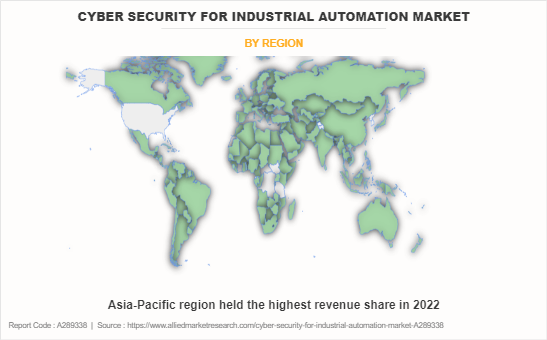
By region, Asia-Pacific dominated the global market in 2022. The demand for cyber security for industrial automation in Asia-Pacific is increasing rapidly as the region has witnessed a significant rise in cyber threats. This is majorly due to rapid digitalization, increased Internet penetration, and geopolitical tensions. In addition, the ransomware attacks have surged in frequency and severity that pose significant threats to various industrial processes. For instance, the attackers often demand cryptocurrency payments for the release of compromised data.
Furthermore, several countries in Asia-Pacific namely India, China, Japan, South Korea, and others are actively pursuing digital transformation initiatives to enhance the efficiency and productivity of industrial processes. Owing to all these factors, the demand for cyber security for industrial automation has become integral to protect digital assets, data, and critical infrastructure in the region.
Impact of COVID-19 on the Global Market
- The COVID-19 pandemic significantly impacted cybersecurity for industrial automation, particularly in the context of industrial control systems (ICS). The sudden shift to remote operations led to new challenges and vulnerabilities that cyber attackers are exploiting at an alarming rate.
- Though remote work offers flexibility, it introduces new cyber security challenges that can lead to unauthorized access and potential cyber threats such as ransomware, phishing, cyber-attacks, and other malware. Cyber attackers are leveraging the uncertainty and distractions associated with the pandemic to launch sophisticated phishing attacks. Phishing emails and SMS lures have become more prevalent, taking advantage of the remote and distracted workforce to gain unauthorized access to industrial networks. Thus, it became necessary to introduce efficient cyber security measures to ensure security of industrial control systems to prevent cyber-attacks.
- Furthermore, the industrial automation systems became potential targets for cybercriminals during the COVID-19 pandemic, seeking to exploit vulnerabilities during a period of increased reliance on digital technologies. In addition, disruptions in global supply chains due to the pandemic led to increased scrutiny on the security of supply chain processes.
Key Benefits for Stakeholders
- The report provides exclusive and comprehensive analysis of the global cyber security for industrial automation market trends along with the cyber security for industrial automation market forecast.
- The report elucidates the cyber security for industrial automation market opportunity along with key drivers, and restraints of the market. It is a compilation of detailed information, inputs from industry participants and industry experts across the value chain, and quantitative and qualitative assessment by industry analysts.
- Porter’s five forces analysis helps analyze the potential of the buyers & suppliers and the competitive scenario of the market for strategy building.
- The report entailing the cyber security for industrial automation market analysis maps the qualitative sway of various industry factors on market segments as well as geographies.
- The data in this report aims on market dynamics, trends, and developments affecting the cyber security for industrial automation market growth.
Cyber Security For Industrial Automation Market Report Highlights
| Aspects | Details |
| Market Size By 2032 | USD 20.5 billion |
| Growth Rate | CAGR of 8.7% |
| Forecast period | 2022 - 2032 |
| Report Pages | 320 |
| By Security Type |
|
| By End Use |
|
| By Type |
|
| By Tools or Technologies |
|
| By Region |
|
| Key Market Players | Microsoft Corporation, Dell Inc., Rockwell Automation Inc., Honeywell International Inc., Siemens AG, Schenider Electric, IBM, Cisco Systems, Inc., Palo Alto Networks, Inc., ABB |
The major growth strategies adopted by cyber security for industrial automation market players are technological advancement, product launch, and partnerships.
Asia-Pacific is projected to provide more business opportunities for the global cyber security for industrial automation market in the future.
IBM, ABB, Schneider Electric, Honeywell International Inc., Siemens AG, Microsoft Corporation, Rockwell Automation Inc., Palo Alto Networks, Cisco Systems, Inc., and Dell Inc. are the major players in the cyber security for industrial automation market.
The programmable automation sub-segment of the type segment acquired the maximum share of the global cyber security for industrial automation market in 2022.
The companies operating in food & beverage manufacturing, pharmaceuticals, electronics & telecommunication, automotive manufacturing, and other sectors are the major customers in the global cyber security for industrial automation market.
The report provides an extensive qualitative and quantitative analysis of the current trends and future estimations of the global cyber security for industrial automation market from 2022 to 2032 to determine the prevailing opportunities.
The use of tool or technologies such as computer numerical control (CNC) systems, industrial sensors, programmable logic controllers (PLCs), numerical control (NC), and others are expected to drive the adoption of cyber security for industrial automation in the upcoming years.
The cyber security for industrial automation market has benefited from technological advancements in recent years. Zero trust architecture, cloud-based security solutions, adoption of artificial intelligence (AI), machine learning (ML), supply chain security, and others is anticipated to boost the cyber security for industrial automation market in the upcoming years.
Loading Table Of Content...
Loading Research Methodology...


